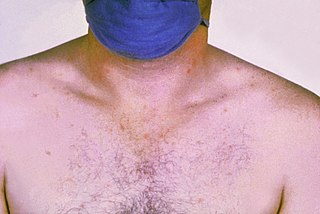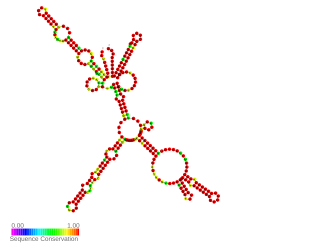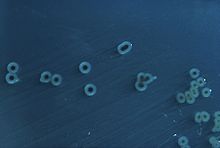
Typhoid fever, also known as typhoid, is a disease caused by Salmonella serotype Typhi bacteria. Symptoms vary from mild to severe, and usually begin six to 30 days after exposure. Often there is a gradual onset of a high fever over several days. This is commonly accompanied by weakness, abdominal pain, constipation, headaches, and mild vomiting. Some people develop a skin rash with rose colored spots. In severe cases, people may experience confusion. Without treatment, symptoms may last weeks or months. Diarrhea may be severe, but is uncommon. Other people may carry it without being affected, but are still contagious. Typhoid fever is a type of enteric fever, along with paratyphoid fever. S. enterica Typhi is believed to infect and replicate only within humans.

Salmonella is a genus of rod-shaped (bacillus) gram-negative bacteria of the family Enterobacteriaceae. The two known species of Salmonella are Salmonella enterica and Salmonella bongori. S. enterica is the type species and is further divided into six subspecies that include over 2,600 serotypes. Salmonella was named after Daniel Elmer Salmon (1850–1914), an American veterinary surgeon.

An asymptomatic carrier is a person or other organism that has become infected with a pathogen, but shows no signs or symptoms.

Salmonellosis is a symptomatic infection caused by bacteria of the Salmonella type. It is the most common disease to be known as food poisoning, these are defined as diseases, usually either infectious or toxic in nature, caused by agents that enter the body through the ingestion of food. In humans, the most common symptoms are diarrhea, fever, abdominal cramps, and vomiting. Symptoms typically occur between 12 hours and 36 hours after exposure, and last from two to seven days. Occasionally more significant disease can result in dehydration. The old, young, and others with a weakened immune system are more likely to develop severe disease. Specific types of Salmonella can result in typhoid fever or paratyphoid fever.

A serotype or serovar is a distinct variation within a species of bacteria or virus or among immune cells of different individuals. These microorganisms, viruses, or cells are classified together based on their surface antigens, allowing the epidemiologic classification of organisms to a level below the species. A group of serovars with common antigens is called a serogroup or sometimes serocomplex.

Paratyphoid fever, also known simply as paratyphoid, is a bacterial infection caused by one of three types of Salmonella enterica. Symptoms usually begin 6–30 days after exposure and are the same as those of typhoid fever. Often, a gradual onset of a high fever occurs over several days. Weakness, loss of appetite, and headaches also commonly occur. Some people develop a skin rash with rose-colored spots. Without treatment, symptoms may last weeks or months. Other people may carry the bacteria without being affected; however, they are still able to spread the disease to others. Typhoid and paratyphoid are of similar severity. Paratyphoid and typhoid fever are types of enteric fever.

Leucine responsive protein, or Lrp, is a global regulator protein, meaning that it regulates the biosynthesis of leucine, as well as the other branched-chain amino acids, valine and isoleucine. In bacteria, it is encoded by the lrp gene.

Salmonella enterica subsp. enterica is a subspecies of Salmonella enterica, the rod-shaped, flagellated, aerobic, Gram-negative bacterium. Many of the pathogenic serovars of the S. enterica species are in this subspecies, including that responsible for typhoid.
The 2012 outbreak of Salmonella took place in 15 places worldwide with over 2,300 strains identified.
Salmonella bongori is a pathogenic bacterium belonging to the genus Salmonella, and was earlier known as Salmonella subspecies V or S. enterica subsp. bongori or S. choleraesuis subsp. bongori. It is a Gram-negative, rod-shaped bacterium (bacillus), which causes a gastrointestinal disease called salmonellosis, characterized by cramping and diarrhoea. It is typically considered a microbe of cold-blooded animals, unlike other members of the genus, and is most frequently associated with reptiles.

Gordon Dougan is a Professor in the Department of Medicine at the University of Cambridge and head of pathogen research and a member of the board of management at the Wellcome Sanger Institute in Cambridge, United Kingdom. He is also a Fellow of Wolfson College, Cambridge. During his career, Dougan has pioneered work on enteric diseases and been heavily involved in the movement to improve vaccine usage in developing countries. In this regard he was recently voted as one of the top ten most influential people in the vaccine world by people working in the area.

OSU-03012 (AR-12) is a celecoxib derivative with anticancer and anti-microbial activity. Unlike celecoxib, OSU-03012 does not inhibit COX, but inhibits several other important enzymes instead which may be useful in the treatment of some forms of cancer, When combined with PDE5 inhibitors such as sildenafil or tadalafil, OSU-03012 was found to show enhanced anti-tumour effects in cell culture.

Edward Thomas Ryan is an American microbiologist, immunologist, and physician at Harvard University and Massachusetts General Hospital. Ryan served as president of the American Society of Tropical Medicine and Hygiene from 2009 to 2010. Ryan is Professor of Immunology and Infectious Diseases at the Harvard T.H. Chan School of Public Health, Professor of Medicine at Harvard Medical School, and Director of Global Infectious Diseases at the Massachusetts General Hospital. Ryan's research and clinical focus has been on infectious diseases associated with residing in, immigrating from, or traveling through resource-limited areas. Ryan is a Fellow of the American Society of Microbiology, the American Society of Tropical Medicine and Hygiene, the American College of Physicians, and the Infectious Diseases Society of America.

The 3′ UTR of mRNA hilD, a master regulator of Salmonella pathogenicity island 1 (SPI-1), is a prokaryotic example of functional 3'UTR. The 3'UTR is a target for hilD mRNA degradation by the degradosome and it may play a role in hilD and SPI-1 expression by serving as a target for the Hfq RNA chaperone. Under non-invasive conditions it is necessary to keep low levels of SPI-1 expression. It plays a role in S. Typhimurium virulence as a regulatory motif.

AsrC is a cis-encoded antisense RNA of rseC described in Salmonella enterica serovar Typhi. It was discovered by deep sequencing and its transcription was confirmed by Northern blot. AsrC is an 893 bp sequence that covers all of the rseC coding region in the reverse direction of transcription. It increases the level of rseC mRNA and protein, indirectly activating RpoE. RpoE can promote flagellar gene expression and motility. Coincidentally, expression of AsrC increased bacterial swimming motility. it is possible that it is because AsrC is promoting the expression of genes related to motility.
Host-directed therapeutics, also called host targeted therapeutics, act via a host-mediated response to pathogens rather than acting directly on the pathogen, like traditional antibiotics. They can change the local environment in which the pathogen exists to make it less favorable for the pathogen to live and/or grow. With these therapies, pathogen killing, e.g.bactericidal effects, will likely only occur when it is co-delivered with a traditional agent that acts directly on the pathogen, such as an antibiotic, antifungal, or antiparasitic agent. Several antiviral agents are host-directed therapeutics, and simply slow the virus progression rather than kill the virus. Host-directed therapeutics may limit pathogen proliferation, e.g., have bacteriostatic effects. Certain agents also have the ability to reduce bacterial load by enhancing host cell responses even in the absence of traditional antimicrobial agents.
Dipshikha Chakravortty is an Indian microbiologist, molecular pathologist and a professor at the department of Microbiology and Cell Biology at the Indian Institute of Science. Known for her studies on Salmonella and antibacterial resistance, Chakravortty is an elected fellow of the National Academy of Sciences, India, the Indian Academy of Sciences and the Indian National Science Academy. The Department of Biotechnology of the Government of India awarded her the National Bioscience Award for Career Development, one of the highest Indian science awards, for her contributions to biosciences, in 2010. Prof. Chakravortty has been elected as an prestigious INSA Council member, which will be functional from January 2024
Santasabuj Das is an Indian medical doctor, molecular immunologist, bioinformatician and a scientist at the National Institute of Cholera and Enteric Diseases, Kolkata. He is known for his studies on the pathogenesis of various types of infections caused by Salmonella in humans and is an elected fellow of the West Bengal Academy of Science and Technology. He is a former Fulbright scholar and a life member of the Probiotic Association of India, the Society of Biological Chemists, India and the Indian Science Congress Association. The Department of Biotechnology of the Government of India awarded him the National Bioscience Award for Career Development, one of the highest Indian science awards, for his contributions to biosciences, in 2011.

In 2000, typhoid fever caused an estimated 21.7 million illnesses and 217,000 deaths. It occurs most often in children and young adults between 5 and 19 years old. In 2013, it resulted in about 161,000 deaths – down from 181,000 in 1990. Infants, children, and adolescents in south-central and Southeast Asia experience the greatest burden of illness. Outbreaks of typhoid fever are also frequently reported from sub-Saharan Africa and countries in Southeast Asia. In the United States, about 400 cases occur each year, and 75% of these are acquired while traveling internationally.
Melita Alison Gordon is a gastroenterologist who works on invasive gut pathogens and tropical gastrointestinal disease. She leads the Malawi Liverpool Wellcome Trust Salmonella and Enterics Group. Gordon was awarded the British Society of Gastroenterology Sir Francis Avery Jones Research Medal in 2011.













